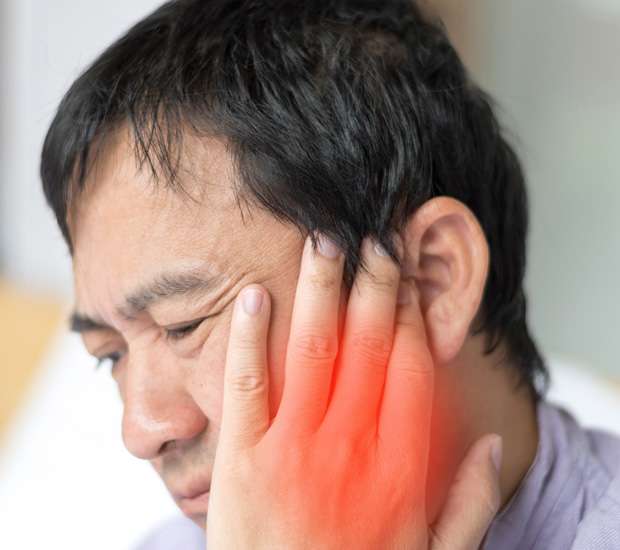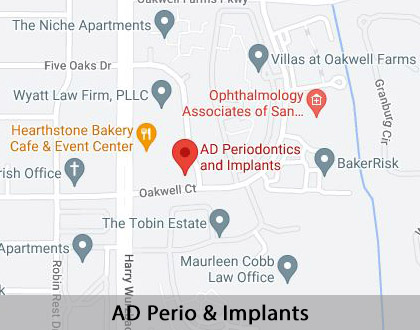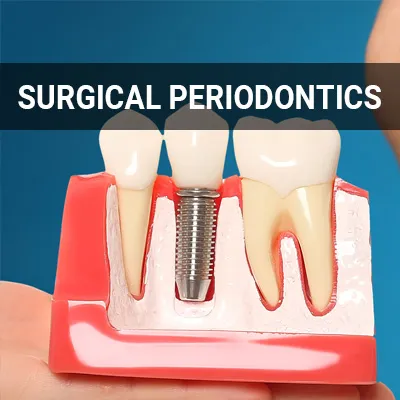Osteonecrosis San Antonio, TX
Osteonecrosis of the jaw, also known as ONJ or osteonecrosis, is a condition in which the jawbone is exposed and starts to starve due to blood deprivation. Osteonecrosis may affect patients taking antiresorptive medications used to treat osteoporosis and cancer.
Osteonecrosis treatment is available at AD Perio & Implants in San Antonio and the surrounding area. Do not hesitate to get the treatment you need. Call us today at (210) 805-8400 to schedule an appointment or learn more about our services.
Understanding Osteonecrosis
The American College of Rheumatology states that the human body's bone and bone marrow comprise of living cells that require a steady blood supply to stay healthy. If this blood flow decreases significantly, the cells may die and the bone may collapse as a result. This process is known as osteonecrosis, and it can lead to pain and limited use of the affected joints.
According to WebMD, avascular necrosis is "the death of bone tissue due to a lack of blood supply." The condition can occur in almost any bone of the body, but when it affects one's dental health, it typically affects the jawbone. It may lead to minuscule breaks in the bone and, eventually, the bone's total collapse. A broken jawbone or dislocated jaw joint may interrupt how the blood flows to a section of the bone. Like arthritis, osteonecrosis may cause severe pain and disability. However, early diagnosis and treatment may improve the outcome.
“The condition can occur in almost any bone of the body, but when it affects one’s dental health, it typically affects the jawbone”
Common Causes of Osteonecrosis
Osteonecrosis is associated with glucocorticoid (or corticosteroid) medicine use and excessive alcohol intake. Other common causes include serious trauma, which interrupts the blood supply to the bone, and systemic lupus erythematosus. Reduced blood supply may also be caused by fatty deposits in blood vessels and certain diseases.
“Osteonecrosis is associated with glucocorticoid (or corticosteroid) medicine use and excessive alcohol intake.”
Symptoms of Osteonecrosis
According to BreastCancer.org, common signs and symptoms of osteonecrosis of the jaw include:
- Bone becoming visible in the mouth
- Draining
- Gums or sockets that do not heal after dental work
- Loose teeth
- Numbness or a heavy feeling in the jaw
- Pain, swelling, redness, or other signs of infection in the gums
However, it is not uncommon to have no symptoms in the early stages of osteonecrosis. The jawbone may only hurt when there is pressure placed on it and only when the condition worsens. Eventually, the pain will be present regardless of whether any pressure is present. Patients should seek immediate medical attention if they have any persistent pain in the jawbone or jaw joint.
“…it is not uncommon to have no symptoms in the early stages of osteonecrosis.”
Check out what others are saying about our dental services on Yelp: Osteonecrosis in San Antonio, TX
Risk Factors for Osteonecrosis
High-dose corticosteroid usage is a common risk factor for osteonecrosis, as is excessive alcohol intake. Certain medical treatments, such as radiation therapy and organ transplantation, may also contribute. Other, less common risk factors for osteonecrosis include decompression disease, blood disorders, HIV infection, radiation therapy, bisphosphonates, and organ transplants. Decompression disease is also known as the "bends" that sometimes occur after scuba diving.
“”High-dose corticosteroid usage is a common risk factor for osteonecrosis, as is excessive alcohol intake.”
Questions Answered on This Page
Q. What are some common causes of osteonecrosis?
Q. What are some of the signs and symptoms of osteonecrosis?
Q. What are some risk factors for osteonecrosis?
Q. How is osteonecrosis treated?
People Also Ask
Q. What are some possible complications of unhealthy gums?
Q. What are the types of gum disease?
Q. What is the purpose of therapeutic treatments for periodontal disease?
Q. What are the pros and cons of surgical periodontics?
Osteonecrosis Treatment
Early osteonecrosis symptoms may be eased with medication and therapy. Depending on the patient's unique case, the dentist may recommend nonsteroidal anti-inflammatory drugs (NSAIDs), osteoporosis drugs, cholesterol-lowering drugs, blood thinners, rest, and exercise. It is possible for patients with osteoporosis to develop osteonecrosis of the jaw. In these cases, they typically undergo conservative treatment with rinses, antibiotics, and oral analgesics.
According to the American College of Rheumatology, studies have shown that conservative treatment is effective for these patients, and there are also case reports of teriparatide use in managing osteonecrosis of the jaw. Possible surgical treatment options include bone grafting and bone reshaping.
“Early osteonecrosis symptoms may be eased with medication and therapy.”
Frequently Asked Questions
Q. How is osteonecrosis of the jaw diagnosed?
A. Osteonecrosis of the jaw is diagnosed via a clinical evaluation. It is diagnosed when the jaw is exposed. Alternatively, it is diagnosed when any amount of necrotic bone is found in the maxilla or mandible for a minimum of eight weeks.
Q. Is osteonecrosis a progressive disease?
A. Yes. Most types of osteonecrosis are progressive, meaning they will only get worse with time. For that reason, it is imperative to treat the problem at the root instead of merely attacking its symptoms.
Q. How can you prevent osteonecrosis?
A. Some cases of osteonecrosis cannot be prevented. However, the best way to prevent osteonecrosis is to decrease the amount of risk factors. Additionally, patients with facial trauma should seek immediate treatment.
Q. Is osteonecrosis painful?
A. Yes. However, this pain is often not noticeable until the disease has already progressed. For this reason, it is crucial to seek immediate treatment if you suspect you are undergoing osteonecrosis.
Q. Are osteonecrosis and avascular necrosis the same thing?
A. Yes. Osteonecrosis and avascular necrosis are synonymous. They may also sometimes be called aseptic necrosis.
Start Feeling Better – Visit Us Today
By visiting us as soon as possible, our team can help get you the professional treatment you need. Instead of waiting around and allowing the symptoms to get worse, we can provide you with treatment options.
Definitions
Call Us Today
Osteonecrosis can lead to total bone loss. We at AD Perio & Implants can help. Call us today at call 210-805-8400 to schedule an appointment or learn more about our services.
Helpful Related Links
- American Academy of Periodontology (AAP). American Academy of Periodontology (AAP). 2023
- Center for Disease Control and Prevention (CDC), Periodontal Disease Page. Center for Disease Control and Prevention (CDC), Periodontal Disease Page. 2023
- WebMD, What Is a Periodontist?. WebMD, What Is a Periodontist?. 2023
About our business and website security
- AD Perio & Implants was established in 2020.
- We accept the following payment methods: American Express, Cash, Check, Discover, MasterCard, and Visa
- We serve patients from the following counties: Bexar County, Kendall County, Comal County, and Guadalupe County
- We serve patients from the following cities: San Antonio, Alamo Heights, Terrell Hills, Universal City, Boerne, Stone Oak, New Braunfels, Bulverde, Fair Oaks Ranch, Garden Ridge, Selma, and Castle Hills
- Norton Safe Web. View Details
- Trend Micro Site Safety Center. View Details
Back to top of Osteonecrosis







